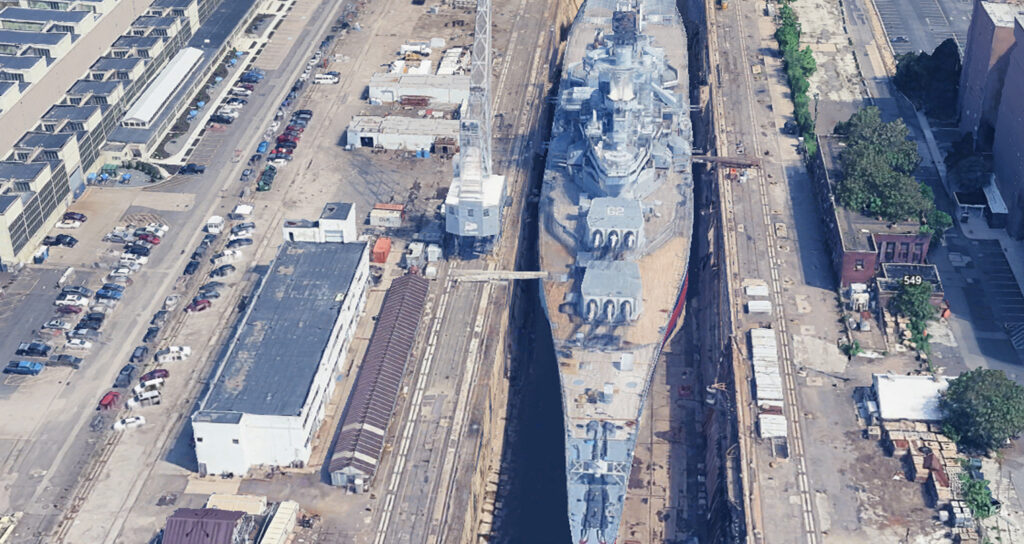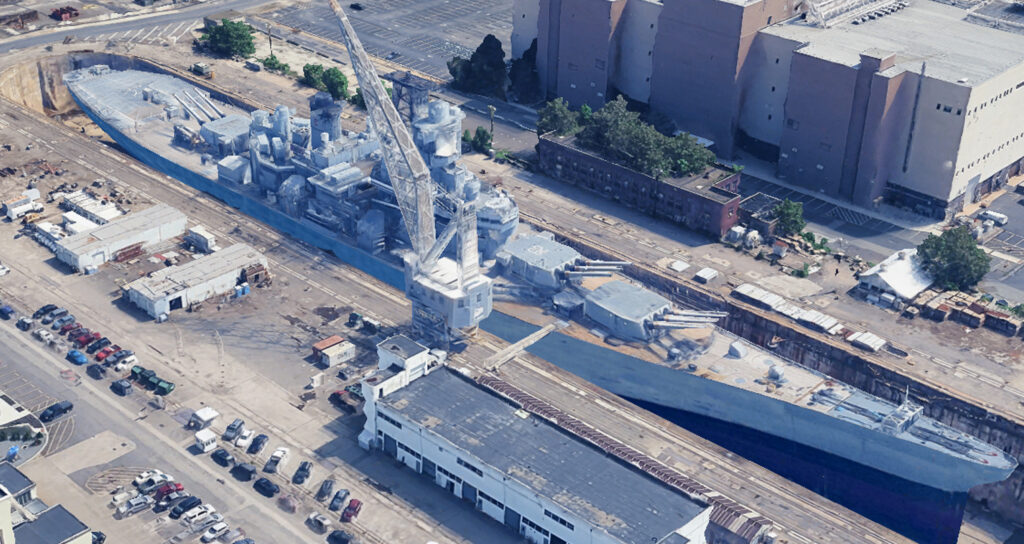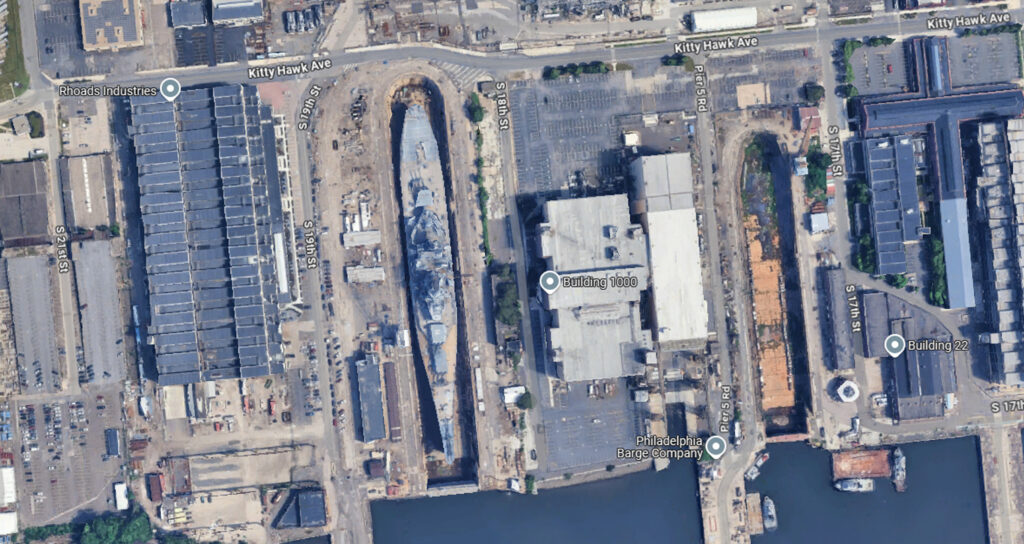Stunning new Google Earth images have captured the iconic USS New Jersey (BB-62), America’s most decorated battleship, resting in Drydock Number Three at the Philadelphia Naval Shipyard.
For the first time in over three decades, the massive Iowa-class warship was towed from its home as a museum ship in Camden, New Jersey, to undergo critical maintenance and repairs, marking a historic homecoming to the very dock where it was launched on December 7, 1942. This $10 million project, which took place from March to June 2024, ensured the preservation of the legendary vessel for future generations.

A Historic Voyage for Repairs
On March 21, 2024, the USS New Jersey embarked on a six-mile journey down the Delaware River, guided by four tugboats from McAllister Towing. The ship first stopped at the Paulsboro Marine Terminal, where 2,000 tons of water were added as ballast to stabilize the hull for drydocking. On March 27, the battleship completed its journey, cruising north to the Philadelphia Naval Shipyard.
The move, which required passing under the Walt Whitman Bridge, was a spectacle that drew crowds and even halted bridge traffic briefly. The ship’s radar was removed to ensure clearance, a testament to the meticulous planning involved.

The drydocking project, overseen by Philadelphia Ship Repair, focused on three critical tasks: repainting the hull to prevent corrosion, replacing 1,200 anodes in the cathodic protection system to combat metal degradation, and inspecting and repairing 160 through-hull openings, some of which had developed leaks.
Additional work included caulking the riveted hull plating and encasing the propeller shafts to protect them as a permanently moored museum ship. The 78-day maintenance period, which concluded on June 20, 2024, was a resounding success, with over 6,000 visitors taking advantage of rare drydock tours to walk beneath the 45,000-ton vessel.
A Storied History
Commissioned on May 23, 1943, the USS New Jersey, affectionately nicknamed “Big J” or “Black Dragon,” is an Iowa-class battleship renowned for its unparalleled service. Launched on the first anniversary of the Pearl Harbor attack, the ship was christened by Carolyn Edison, wife of then-New Jersey Governor Charles Edison. Its main battery of nine 16-inch/50 caliber Mark 7 guns could fire 2,700-pound shells up to 23 miles, while its secondary battery included twenty 5-inch/38 caliber guns. The battleship’s teak main deck spanned 53,000 square feet, and at 887 feet, 7 inches long, it was the longest battleship in U.S. Navy history.
The USS New Jersey earned 19 battle stars across its 21 years of active service, more than any other U.S. battleship. During World War II, it supported amphibious campaigns in the Pacific, including Guam, Okinawa, and the Marshall Islands, screening aircraft carriers and bombarding enemy targets. In the Korean War, it conducted raids along the North Korean coast, and in 1968, it was reactivated to provide gunfire support during the Vietnam War, firing 29 sixteen-inch rounds on September 30 near the Demilitarized Zone. The ship also saw action in Lebanon and the Persian Gulf in the 1980s before its final decommissioning in February 1991.
After its retirement, the USS New Jersey was towed from Bremerton, Washington, to Philadelphia in 1999 for restoration, before finding its permanent home in Camden as a museum ship in 2001. The Battleship New Jersey Museum and Memorial has since welcomed visitors to explore its berthing spaces, navigational bridge, and 16-inch gun turrets, offering an immersive look at naval history.
A Once-in-a-Generation Opportunity
The drydocking was long overdue, as Navy guidelines recommend maintenance every 20 years for decommissioned ships, and the USS New Jersey had not been out of the water since 1991. The $10 million project was partially funded by a $5 million grant from the New Jersey Historical Commission, with additional support from a “Donate to Drydock” campaign and ticket sales for drydock tours, priced at $225 for standard tours and $1,000 for exclusive tours with curator Ryan Szimanski. The tours, offered on weekends, allowed visitors to see the ship’s hull up close, a rare chance described as a “once-in-a-generation opportunity” by museum CEO Marshall Spevak.
The project was not without challenges. The Home Port Alliance, which operates the museum, faced financial hurdles to complete the financing, relying on public donations to bridge the gap. The move itself required coordination with the U.S. Coast Guard, which established a security perimeter, and careful navigation to avoid potential risks after 22 years of immobility. Despite these obstacles, the operation was a triumph, with the ship returning to Camden on June 20, 2024, ready to resume its role as a floating museum.
Preserving a National Treasure
The USS New Jersey’s drydocking underscores the importance of preserving naval history. As the fastest battleship in history, reaching 35.2 knots (over 40 mph) in 1968, and the most decorated, with nine battle stars from World War II, four from Korea, three from Vietnam, and three from later conflicts, the ship is a testament to the bravery of the 45,000 sailors and Marines who served aboard it. Its return to the Philadelphia Naval Shipyard, where it was built in the late 1930s, was a symbolic homecoming, reconnecting the vessel with its origins.
For veterans like Ken Kersch, who served on the ship during Vietnam and has worked at the museum since 2001, the USS New Jersey is more than a ship—it’s a family. “The crew was young but seasoned,” Kersch recalled. “There was harmony to the way we worked. It was a family atmosphere.” The drydocking ensures that this legacy endures, allowing future generations to walk its decks and learn about the sacrifices of those who served.
As the USS New Jersey settles back into its Camden berth, the Google Earth images serve as a lasting record of this historic moment. The Battleship New Jersey Museum and Memorial continues to welcome visitors daily from 10:00 AM to 4:00 PM, inviting all to experience the grandeur and history of this American icon. For more information or to donate to the ship’s ongoing preservation, visit BattleshipNewJersey.org.
